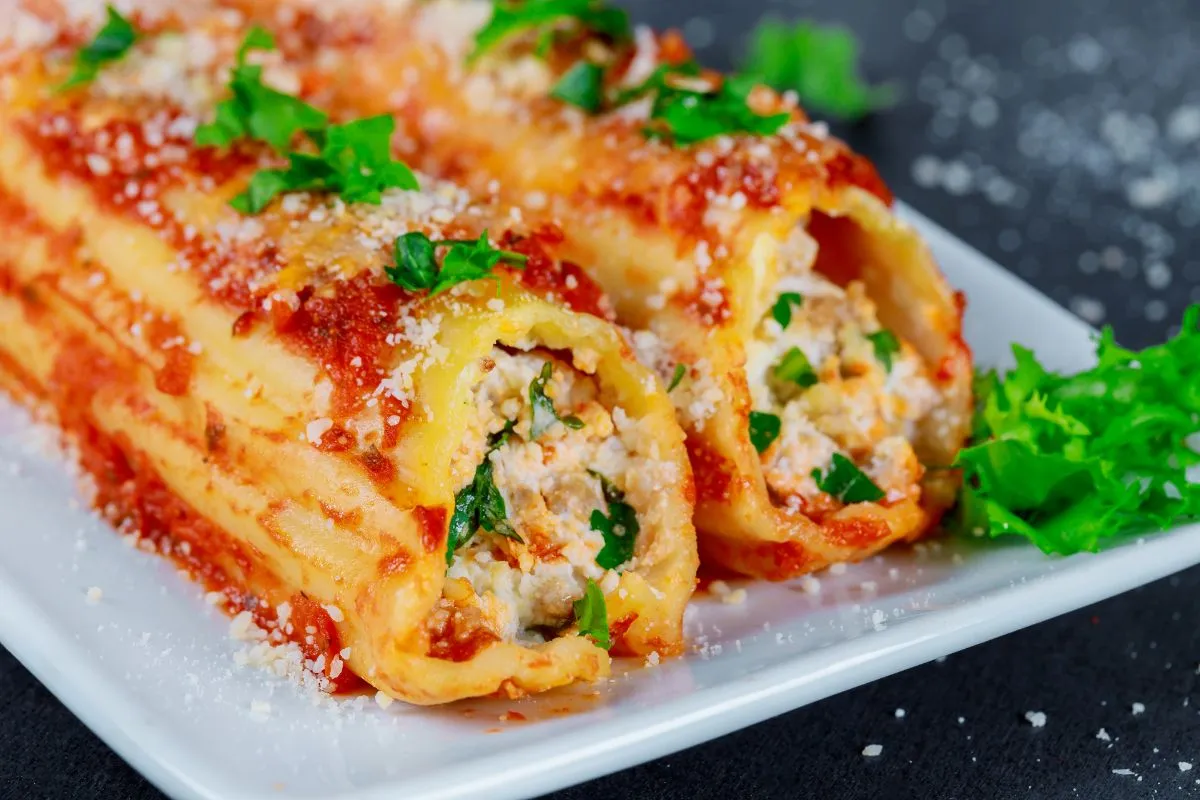Introduction to Manicotti
Manicotti, a staple in the realm of Italian cuisine, stands out as a heartwarming dish that brings a slice of Italy right to your dinner table. This large, tube-shaped pasta, traditionally stuffed with a rich blend of cheeses, is a testament to the simplicity and elegance of Italian cooking. But what exactly is manicotti, and how did it become such a beloved dish?
Definition and Origin of Manicotti
Manicotti, often mistaken as an ancient Italian dish, is actually a delightful product of Italian-American innovation. The word “manicotti” literally translates to “little sleeves” in Italian, aptly describing the pasta’s tubular shape. It’s akin to cannelloni, yet distinct in its preparation and presentation. The concept of stuffing pasta with cheese and baking it in a savory tomato sauce has its roots in Italian culinary traditions, but manicotti as we know it today is a dish that evolved in the kitchens of Italian immigrants in America.
Popular Variations of Manicotti
While the traditional version of this stuffed pasta is a cheese lover’s dream, boasting a mix of ricotta, mozzarella, and Parmesan, numerous variations exist. Some adaptations include spinach or meat in the filling, providing a delightful twist. Others explore different sauces, such as creamy béchamel or zesty pesto, to enhance the dish’s flavor profile.
Manicotti’s versatility is part of its charm. Whether you’re a purist who loves the classic cheese and tomato sauce combination or an adventurous cook eager to experiment, manicotti offers a canvas for culinary creativity.
Ingredients and Preparation
Creating a mouth-watering manicotti begins with selecting the right ingredients and understanding the preparation process. Let’s delve into the essentials that make this dish a true Italian delight.
Essential Ingredients for Manicotti
Pasta Types: Fresh vs. Dried
The soul of manicotti lies in its pasta. You have two choices: fresh or dried. Fresh pasta sheets, rolled into tubes, offer a delicate texture that’s hard to beat. Dried manicotti shells, on the other hand, provide convenience and a firmer bite. Whichever you choose, remember that the pasta is more than just a vessel for the filling—it’s a crucial component that can make or break your dish.
Cheese Selection: Ricotta, Mozzarella, Parmesan
Cheese is the heart of manicotti. A creamy ricotta forms the base, providing a smooth, rich filling. Mozzarella brings a delightful stretchiness, and a sprinkle of Parmesan adds a sharp, salty kick. The key is to balance these cheeses for a filling that’s flavorful yet not overpowering.
Sauce Options: Homemade Tomato Sauce and Alternatives
A good tomato sauce ties the dish together. While a homemade sauce, simmered with herbs and spices, elevates the dish, don’t shy away from a high-quality jarred sauce for convenience. For those looking to venture beyond tomato, a béchamel or pesto sauce can add a unique twist to your manicotti.
Preparing the Manicotti Filling
Mix your cheeses with finesse, ensuring each component is well integrated. Season with salt, pepper, and perhaps a hint of nutmeg for a touch of warmth. For an extra layer of flavor, consider adding finely chopped herbs like parsley or basil.
Rolling and Filling Techniques
If using fresh pasta, cut the sheets into rectangles and gently roll them around your filling. For dried shells, a piping bag can be a handy tool to stuff the cheese mixture neatly inside. The goal is to achieve a harmonious balance of pasta and filling, ensuring every bite is as delightful as the last.
Freezing Manicotti
Freezing manicotti is a fantastic way to enjoy this classic dish with minimal effort on busy days. For more easy family dinner ideas, check out our Dump and Bake Manicotti recipe. Let’s walk through the process of freezing manicotti effectively, ensuring that it retains its flavor and texture.
Benefits of Freezing Manicotti
Freezing manicotti is not just about convenience; it’s also about flavor. As the manicotti rests in the freezer, the flavors meld together, resulting in a more cohesive and rich taste upon baking. Additionally, having a ready-to-bake meal in the freezer can be a lifesaver on hectic days or when unexpected guests arrive.
Step-by-Step Guide to Freezing Manicotti
- Assembling the Dish: Follow your recipe to prepare and fill the pasta shells. Whether opting for fresh or dried varieties, be mindful not to overcook them, as they will continue cooking in the oven.
- Choose the Right Container: Use a freezer-safe dish. If you plan to bake the manicotti in the same dish, consider using a disposable aluminum tray for convenience.
- Layering: Start with a thin layer of sauce at the bottom of the dish. This prevents sticking and adds moisture. Arrange the filled manicotti in a single layer.
- Saucing: Cover the manicotti with your sauce of choice, ensuring they are completely coated. This helps prevent freezer burn and keeps the pasta moist.
- Wrapping: Cover the dish tightly with plastic wrap, then add a layer of aluminum foil. This double layer helps preserve the flavors and textures.
Tips for Proper Storage and Freezing Duration
- Label and Date: Always label your dish with the date of freezing. Manicotti can be stored in the freezer for up to 3 months without losing its quality.
- Avoid Freezer Burn: Ensure the manicotti is wrapped tightly and securely to prevent freezer burn, which can affect taste and texture.
- Thawing (Optional): While you can bake manicotti straight from the freezer, thawing it in the refrigerator overnight can reduce the baking time.
Baking Manicotti
Baking is the final step that transforms your manicotti into a golden, bubbling delight. Whether you’re baking it straight from the freezer or after thawing, here’s how to ensure your manicotti turns out perfectly every time.
To Defrost or Not: Pros and Cons
- Baking From Frozen: The convenience of baking manicotti directly from the freezer is undeniable. It may take a bit longer, but the result is just as delicious. The key is to bake it covered initially, then uncover to allow the top to brown.
- Baking After Thawing: Thawing manicotti in the refrigerator can shorten the baking time and sometimes results in a more evenly heated dish. If you choose to thaw, remember to do so in the fridge, not at room temperature, to maintain food safety.
Baking Instructions for Frozen vs. Thawed Manicotti
- Preheat Your Oven: Whether baking frozen or thawed, preheat your oven to 375°F (190°C).
- Baking Time for Frozen Manicotti: Place the frozen manicotti, still covered, in the oven. Bake for about 45-60 minutes. Then, remove the cover and bake for an additional 10-15 minutes to get a golden-brown top.
- Baking Time for Thawed Manicotti: If thawed, bake for 35-45 minutes covered, then an additional 10-15 minutes uncovered.
Ensuring Perfect Texture and Flavor
- Don’t Overbake: Keep an eye on your manicotti to ensure it doesn’t overbake, which can lead to dryness.
- Let it Rest: After baking, let the manicotti rest for about 10-15 minutes. This allows the cheese to set and makes serving easier.
- Check for Doneness: The manicotti should be bubbling around the edges, and the cheese melted and slightly golden.
Serving and Pairing
Once your manicotti is perfectly baked, it’s time to think about serving and pairing to elevate this dish to a full dining experience. Here are some suggestions to complement your manicotti and impress your guests or family.
Ideal Side Dishes and Wine Pairings
- Wine: A robust Italian red wine, like a Sangiovese or Barbera, pairs beautifully with the rich flavors of manicotti. The acidity and tannins in these wines balance the creaminess of the cheese and the sweetness of the tomato sauce. For more on Italian Red Wine Pairings, check out this guide.
- Salad: A simple mixed green salad with a light vinaigrette offers a fresh, crisp contrast to the richness of the manicotti. It’s a refreshing side that cleanses the palate.
- Bread: No Italian meal is complete without bread. A crusty loaf of Italian bread or garlic bread is perfect for sopping up the delicious sauce. Discover how to make quick and crispy Garlic Bread in an Air Fryer for a perfect side to your manicotti.
Presentation Tips for an Appealing Dish
- Garnish: A sprinkle of fresh basil or parsley adds a pop of color and a fresh aroma just before serving.
- Plating: Present the dish with a generous scoop of sauce, a sprinkle of grated Parmesan, or a drizzle of olive oil to enhance the flavors.
Customizing Your Manicotti
Manicotti is a wonderfully versatile dish, allowing for a range of creative customizations. Whether you’re looking to add a personal touch or cater to different dietary preferences, here are some ideas to make your manicotti uniquely delicious.
Creative Filling Ideas: Meat, Vegetables, and Cheeses
- Meat Lovers: For a heartier dish, consider adding cooked ground beef, sausage, or even small meatballs to your cheese filling. This addition transforms the manicotti into a more substantial meal.
- Vegetarian Variations: Spinach is a classic addition, but don’t stop there. Try sautéed mushrooms, roasted red peppers, or caramelized onions for a depth of flavor. For those who enjoy a bit of crunch, finely chopped nuts like walnuts or pine nuts can add an interesting texture.
- Cheese Variations: While ricotta, mozzarella, and Parmesan are traditional, feel free to experiment with other cheeses. Smoked provolone can add a hint of smokiness, while a dollop of mascarpone can make the filling creamier. For a tangy twist, try adding a bit of goat cheese.
Alternative Sauces: Vodka, Cream, and Pesto
- Vodka Sauce: A creamy vodka sauce can add a luxurious richness to manicotti. Its slightly tangy and creamy profile is a delightful change from the usual tomato sauce.
- Cream Sauce: For a decadent twist, a béchamel or Alfredo sauce can envelop the manicotti in creamy goodness. This is especially good with spinach or mushroom fillings.
- Pesto Sauce: A vibrant pesto sauce adds a fresh and herby dimension. This pairs wonderfully with the cheese-filled pasta, offering a delightful alternative to traditional tomato-based sauces.
How to Cook Frozen Manicotti FAQs
When it comes to preparing frozen stuffed pasta, several questions often arise. Let’s address these frequently asked questions to guide you towards perfecting this Italian dish.
What are some other ingredients I can use in my manicotti?
- For the Filling: Beyond the traditional cheese, you can experiment with various ingredients like sautéed spinach, finely chopped cooked chicken, or even a dash of pesto for added flavor.
- For the Sauce: While tomato sauce is classic, don’t hesitate to try alternatives like a creamy béchamel, a rich meat sauce, or even a light and herby pesto sauce for a different twist.
Which other cheeses could enhance my manicotti recipe?
- Cheese Varieties: If you’re looking to explore beyond ricotta, mozzarella, and Parmesan, consider using cottage cheese for a lighter texture, or a blend of Italian cheeses like fontina or gorgonzola for a more complex flavor profile.
What are some other sauces I can use for my manicotti besides tomato sauce?
- Sauce Options: A pink vodka sauce can add a touch of elegance, while a white garlic cream sauce can offer a rich and indulgent alternative. For a lighter option, a pesto cream sauce can bring a fresh and vibrant flavor to your manicotti.
How long will the manicotti last in the freezer?
- Freezer Duration: Properly stored, frozen manicotti can last up to 6 months in the freezer without losing its quality. Just make sure it’s wrapped tightly to prevent freezer burn.
What should I serve with my manicotti?
- Pairing Suggestions: A glass of Italian red wine, like a Chianti or Montepulciano, pairs beautifully with manicotti. For sides, consider a crisp green salad or some garlic bread to complement the rich flavors of the dish.
The History and Cultural Significance of Manicotti
Manifesting the rich tapestry of Italian-American heritage, manicotti is more than just a dish; it’s a cultural emblem. Tracing its roots back to the Italian immigrants who brought their culinary traditions to America, manicotti has evolved over the years. Originally, Italian cooks used crepes to wrap the filling, a method still used in some authentic recipes. This evolution reflects the adaptability and creativity of Italian-American cuisine, blending traditional Italian cooking with new-world innovations.
The Art of Choosing the Right Ingredients
Selecting the right ingredients is akin to an artist choosing their palette – it can make a world of difference in the final creation. High-quality, fresh ingredients are the cornerstone of delicious manicotti. Opt for whole milk ricotta for creaminess, fresh herbs for aroma, and homemade or artisanal tomato sauce for depth of flavor. The choice of cheese, from a sharp Parmesan to a smooth mozzarella, can significantly alter the taste profile, making each manicotti dish a unique culinary adventure.
Tips for Perfect Pasta Preparation
Perfect pasta preparation is crucial for the ideal manicotti. If using dried pasta, ensure it’s al dente to prevent it from becoming too soft during baking. For fresh pasta, aim for a thin, even roll that cooks evenly while retaining its texture. This section can delve into the nuances of pasta preparation, offering readers insider tips on achieving the perfect pasta texture every time.
Advanced Techniques for Manicotti Masters
For those looking to elevate their manicotti, advanced techniques can add complexity and depth. This could include making homemade pasta from scratch, experimenting with layered fillings, or incorporating unique ingredients like truffle oil or exotic cheeses. Discussing advanced culinary techniques will not only cater to experienced cooks but also inspire beginners to expand their cooking repertoire.
The Role of Manicotti in Modern Cuisine
Manicotti’s role in modern cuisine is ever-evolving. Today, this dish is a canvas for fusion flavors, dietary adaptations like gluten-free or vegan options, and even deconstructed presentations. This section can explore how manicotti is being reimagined in contemporary kitchens, from high-end restaurants to home cooking, reflecting the dynamic nature of food and taste.
Conclusion
As we conclude our detailed guide, let’s revisit the essential insights for crafting this delightful Italian dish with confidence and creativity.
This pasta, known for its rich cheese filling and savory sauce, is more than a mere meal; it represents a journey into the heart of Italian-American culinary traditions. Whether adhering to the traditional recipe or exploring custom variations, this dish serves as a versatile medium for culinary artistry.
The choice of pasta, be it fresh for a delicate touch or dried for convenience, significantly impacts the dish’s texture. The heart of the recipe lies in its cheese filling – a harmonious blend of creamy ricotta, stretchy mozzarella, and sharp Parmesan. However, feel free to experiment with various cheeses and fillings to tailor it to your taste.
Opting to freeze this pasta dish not only offers convenience but also enhances the flavors. Proper baking techniques are crucial, whether you’re cooking it straight from the freezer or after thawing, to ensure a perfectly baked outcome.
Pairing this dish with suitable accompaniments like a robust Italian wine, a fresh salad, and crusty bread can transform your meal into an authentic Italian feast, making it an experience to remember.



